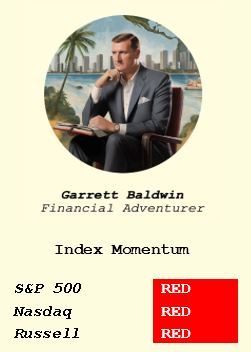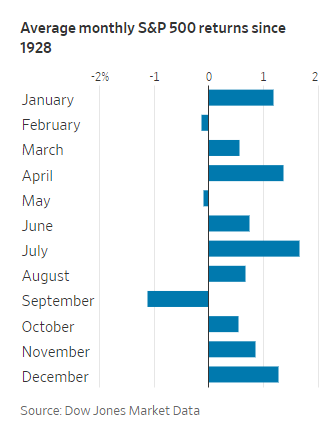

Greetings from Baltimore.
If there’s ever a reason to depart from the Florida Republic, it’s for a crab cake, yellow mustard, and crackers.
Provisions are well stocked in the Charm City.
We enter a pivotal week for the markets. The Chinese central bank didn’t pump another 1 trillion Yuan into its economy, so the “trend” – or expected performance for the S&P 500 and Russell 2000 – is likely set for lower highs and lower lows. The Federal Reserve’s meeting in Jackson Hole, Wyoming, delivered no major updates – except our existing commitment to higher interest rates for longer.
Without a major move by central banks – and the meeting among the BRICS nations (Brazil, Russia, India, China, South Africa, etc.) largely being a bust – we can turn our attention to the more behavioral elements in the stock market.
September is coming.
Will We See a Crash in September?

With a week left before Labor Day, we must look at the chart to the left.
It shows the average monthly returns of the S&P 500 since 1928.
Most people think that October is the worst month.
They associate that month with the crash of investment bank Lehman Brothers in October 2008.
But it turns out that the average S&P 500 performance sits below NEGATIVE -1%.
Let’s back up quickly. What is seasonality?
Stock market seasonality refers to recurring patterns in stock prices based on specific times of the year. This is largely an anomaly. But the factors behind it include investor behavior, economic cycles, and events tied to specific months.
We know that if enough people believe something… it can become true. It can be a self-fulfilling prophecy. Even though we need to do more analysis when making investment decisions, it’s not stunning when performance is attributed to these phenomena.
For instance, the "January Effect" reflects historically strong January performances. This year's rally in January was largely fueled by big capital injections by the Bank of Japan and the People’s Bank of China… BUT – seasonality helped add some fuel to the fire.
Then, the "Sell in May and Go Away" strategy suggests weaker summer months.
This brings us to September… a period on the calendar that most people dread. It’s the market equivalent of going on an annual trip you don’t want to join. It can lighten your wallet and make you crazy very quickly.
The good news? We’re prepared. We have a strategy in place.
Momentum Red – Enjoy Your Last Week
It’s the last week of “Summer” for many of us. With our momentum reading negative, the last thing I want to do is start worrying about the equity markets.
There are plenty of reasons why other people are worried about September. China’s economy is under stress. Interest rates in the U.S. are heading higher. Japanese institutions might need to dump U.S. bonds. And there are always “unknown… unknowns.”
As we look out to the next month, I want to conclude with one last chart.
Not only is September a historically bad month for the S&P 500, but it is also a period when volatility tends to pick up.
Stock market volatility tracks the price fluctuations in stocks over a specific period.
Volatility indicates the market's instability and risk level. So, when volatility picks up, you can assume that there’s lots of concern about the performance of the market itself.
High volatility suggests rapid price changes, often due to economic news, geopolitical events, investor sentiment shifts, and market seasonality.
Volatility last spiked in March, when the market tanked due to a big worry over regional bank collapses and questions about the stability of our financial system. Since then, volatility has slumped, meaning that markets have increased, and stock owners have been happy.

But look at this chart to the right. The purple line measures S&P 500 volatility averages over the last 32 years. The blue line is the measurement of volatility this year.
As you can see, seasonal volatility has largely tracked the performance of the last three decades.
And there’s good reason to expect fireworks over the next 35 days.
For now, we’re largely in cash, holding our oil-and-gas stocks, building income-generating positions, and waiting. When momentum is red, we don’t worry.
Now… who’s up for a second crab cake?
Stay positive,
Garrett Baldwin
Secretary of Finance


